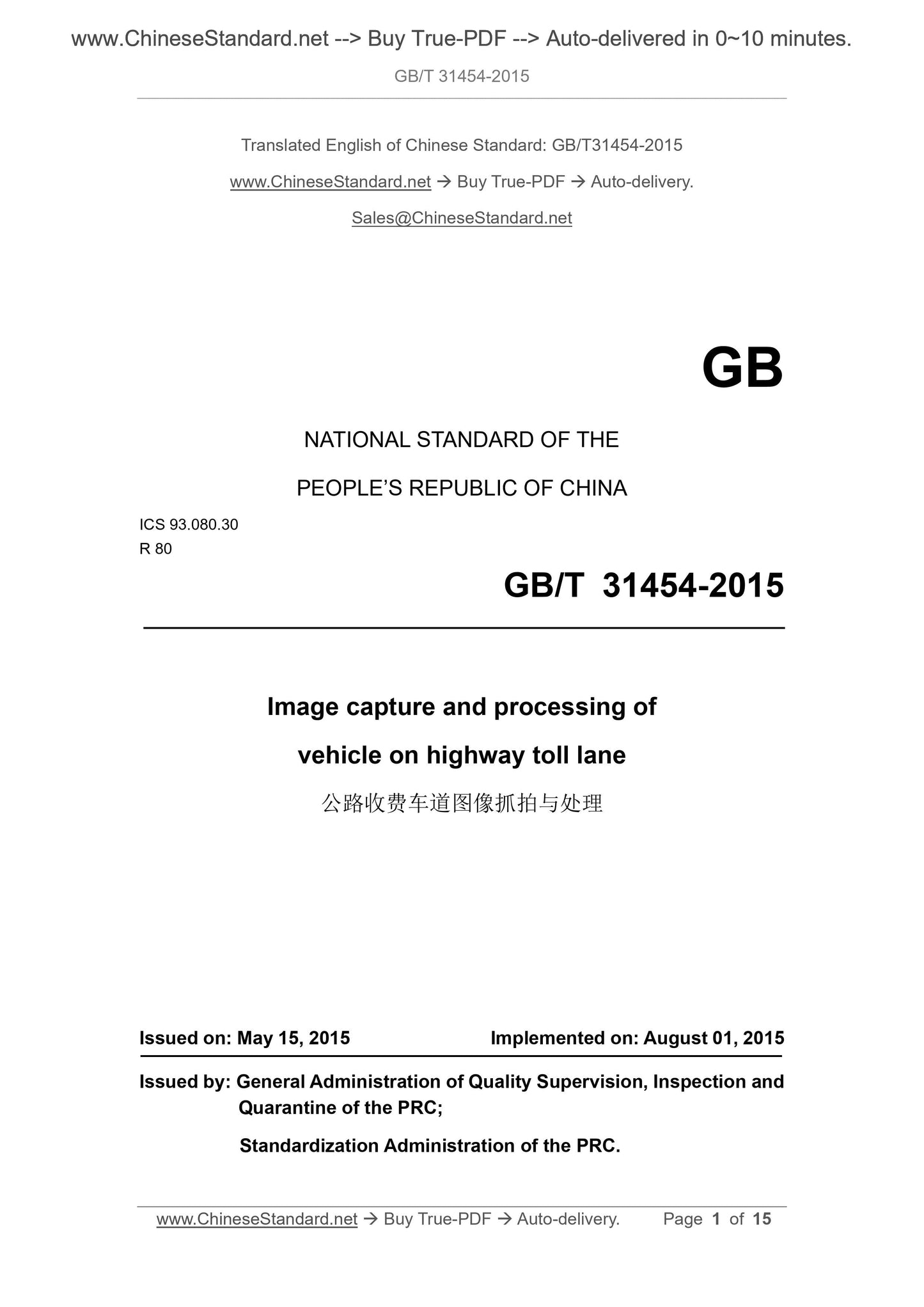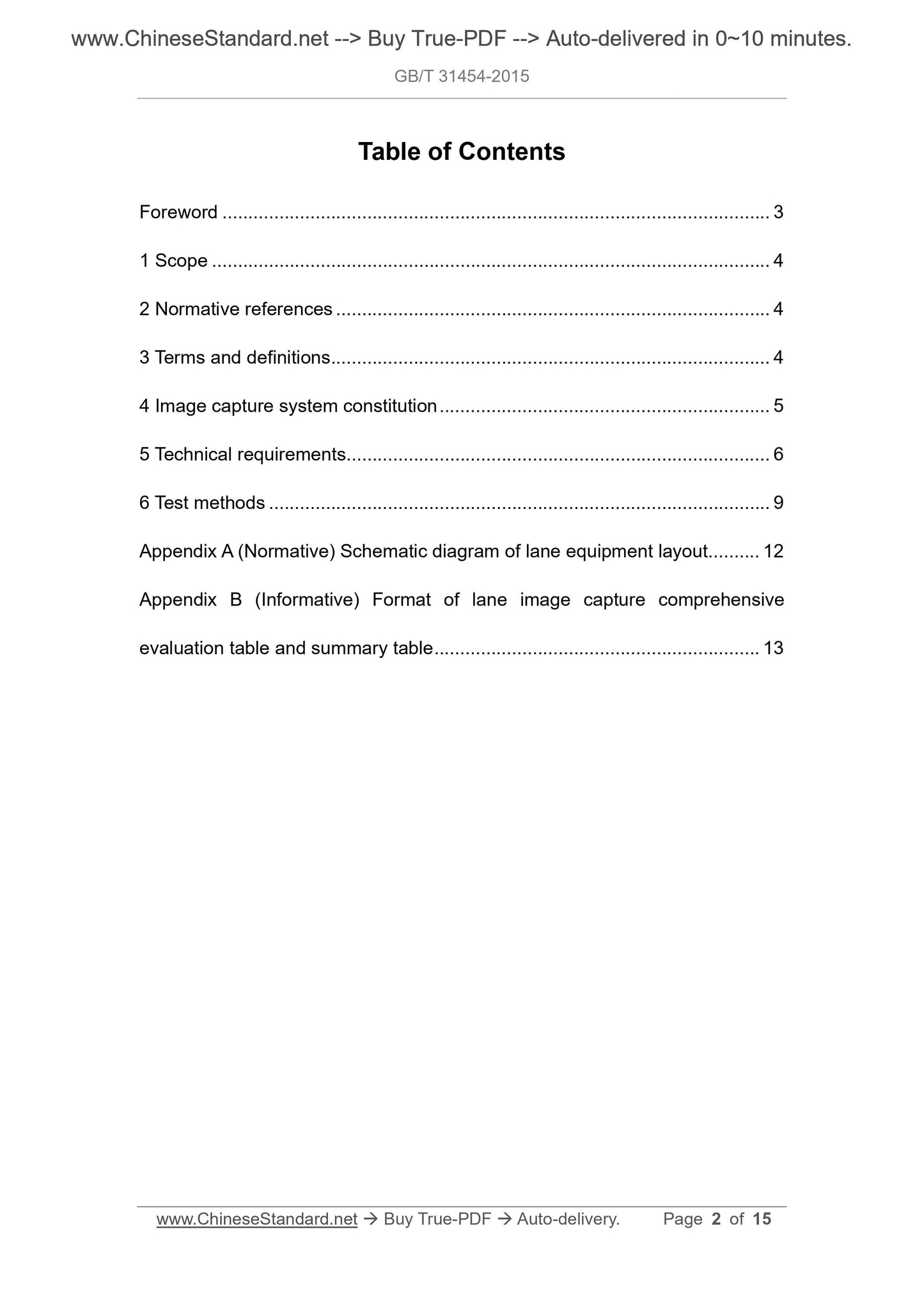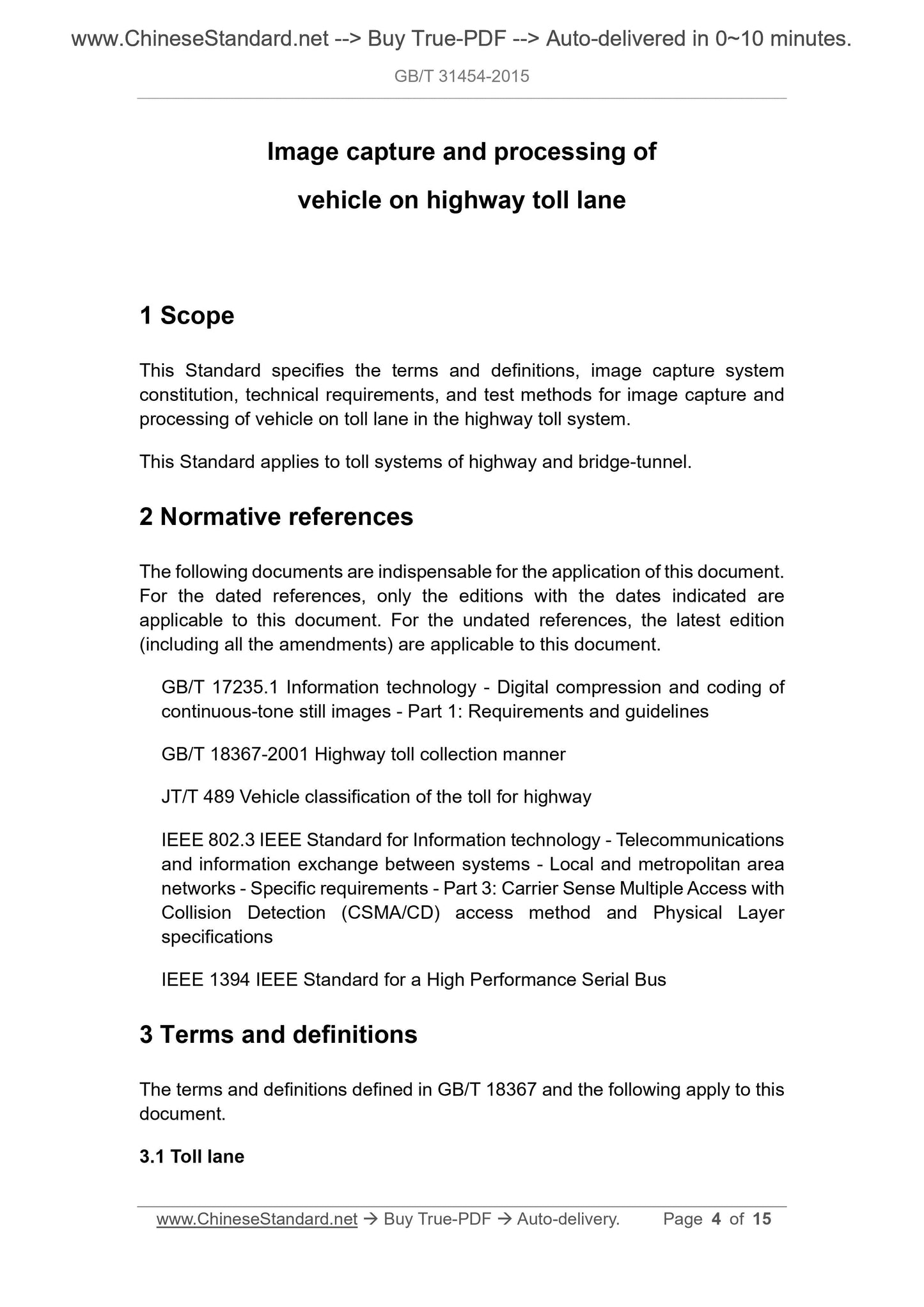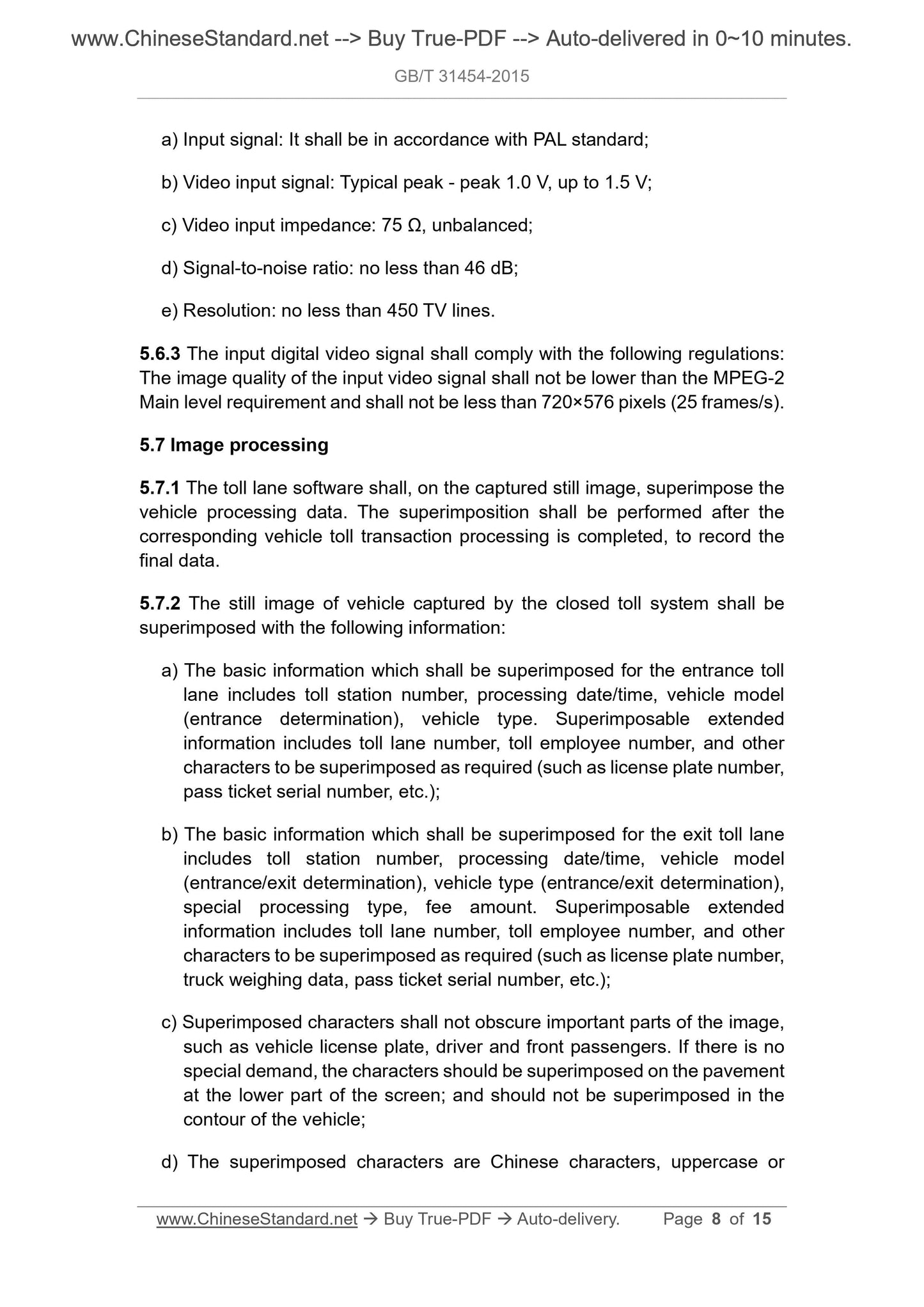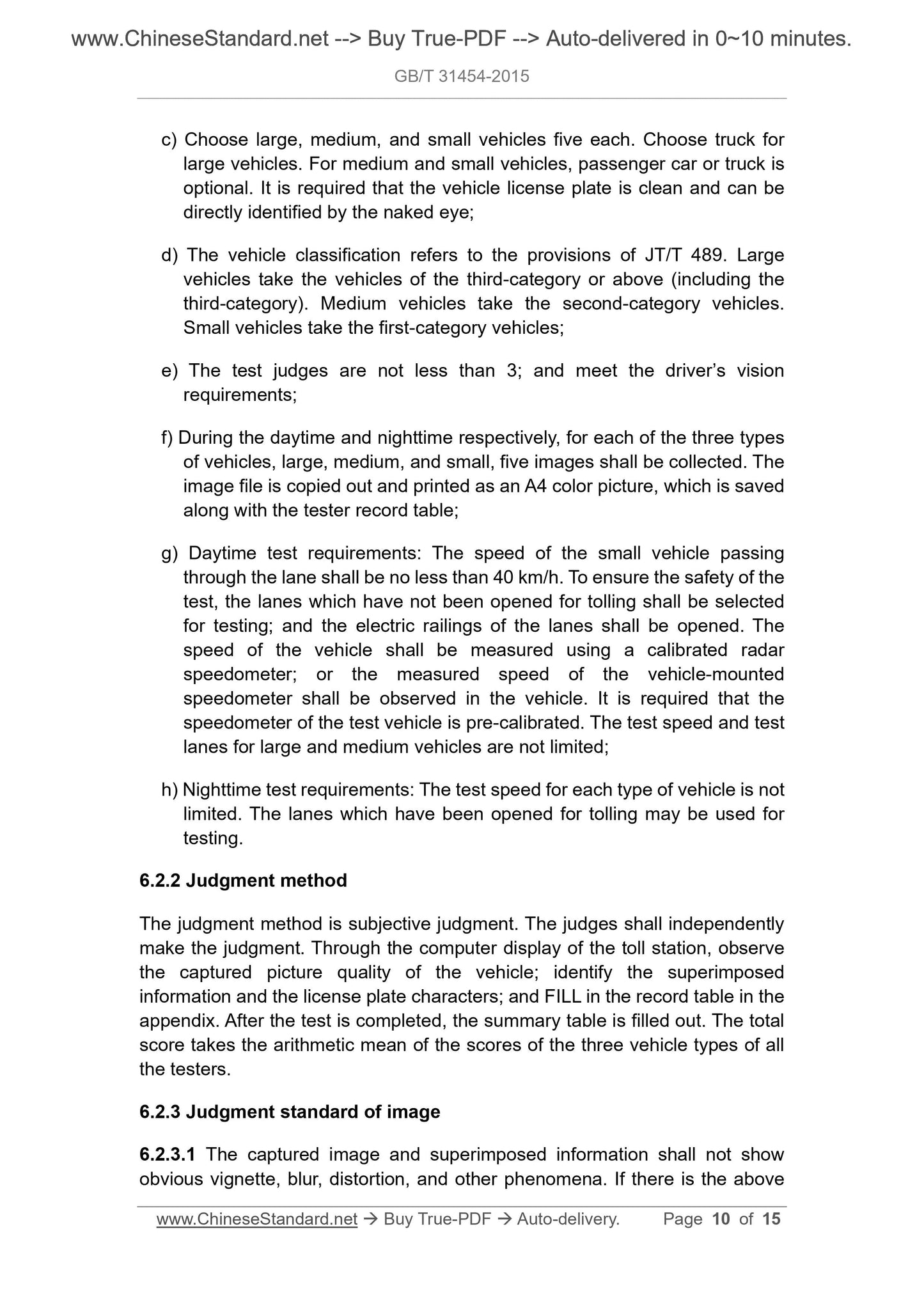1
/
of
5
www.ChineseStandard.us -- Field Test Asia Pte. Ltd.
GB/T 31454-2015 English PDF (GB/T31454-2015)
GB/T 31454-2015 English PDF (GB/T31454-2015)
Regular price
$140.00
Regular price
Sale price
$140.00
Unit price
/
per
Shipping calculated at checkout.
Couldn't load pickup availability
GB/T 31454-2015: Image capture and processing of vehicle on highway toll lane
Delivery: 9 seconds. Download (& Email) true-PDF + Invoice.
Get Quotation: Click GB/T 31454-2015 (Self-service in 1-minute)
Historical versions (Master-website): GB/T 31454-2015
Preview True-PDF (Reload/Scroll-down if blank)
GB/T 31454-2015
NATIONAL STANDARD OF THE
PEOPLE’S REPUBLIC OF CHINA
ICS 93.080.30
R 80
Image capture and processing of
vehicle on highway toll lane
ISSUED ON: MAY 15, 2015
IMPLEMENTED ON: AUGUST 01, 2015
Issued by: General Administration of Quality Supervision, Inspection and
Quarantine of the PRC;
Standardization Administration of the PRC.
Table of Contents
Foreword ... 3
1 Scope ... 4
2 Normative references ... 4
3 Terms and definitions ... 4
4 Image capture system constitution ... 5
5 Technical requirements ... 6
6 Test methods ... 9
Appendix A (Normative) Schematic diagram of lane equipment layout ... 12
Appendix B (Informative) Format of lane image capture comprehensive
evaluation table and summary table ... 13
Image capture and processing of
vehicle on highway toll lane
1 Scope
This Standard specifies the terms and definitions, image capture system
constitution, technical requirements, and test methods for image capture and
processing of vehicle on toll lane in the highway toll system.
This Standard applies to toll systems of highway and bridge-tunnel.
2 Normative references
The following documents are indispensable for the application of this document.
For the dated references, only the editions with the dates indicated are
applicable to this document. For the undated references, the latest edition
(including all the amendments) are applicable to this document.
GB/T 17235.1 Information technology - Digital compression and coding of
continuous-tone still images - Part 1: Requirements and guidelines
GB/T 18367-2001 Highway toll collection manner
JT/T 489 Vehicle classification of the toll for highway
IEEE 802.3 IEEE Standard for Information technology - Telecommunications
and information exchange between systems - Local and metropolitan area
networks - Specific requirements - Part 3: Carrier Sense Multiple Access with
Collision Detection (CSMA/CD) access method and Physical Layer
specifications
IEEE 1394 IEEE Standard for a High Performance Serial Bus
3 Terms and definitions
The terms and definitions defined in GB/T 18367 and the following apply to this
document.
3.1 Toll lane
a) Input signal: It shall be in accordance with PAL standard;
b) Video input signal: Typical peak - peak 1.0 V, up to 1.5 V;
c) Video input impedance: 75 Ω, unbalanced;
d) Signal-to-noise ratio: no less than 46 dB;
e) Resolution: no less than 450 TV lines.
5.6.3 The input digital video signal shall comply with the following regulations:
The image quality of the input video signal shall not be lower than the MPEG-2
Main level requirement and shall not be less than 720×576 pixels (25 frames/s).
5.7 Image processing
5.7.1 The toll lane software shall, on the captured still image, superimpose the
vehicle processing data. The superimposition shall be performed after the
corresponding vehicle toll transaction processing is completed, to record the
final data.
5.7.2 The still image of vehicle captured by the closed toll system shall be
superimposed with the following information:
a) The basic information which shall be superimposed for the entrance toll
lane includes toll station number, processing date/time, vehicle model
(entrance determination), vehicle type. Superimposable extended
information includes toll lane number, toll employee number, and other
characters to be superimposed as required (such as license plate number,
pass ticket serial number, etc.);
b) The basic information which shall be superimposed for the exit toll lane
includes toll station number, processing date/time, vehicle model
(entrance/exit determination), vehicle type (entrance/exit determination),
special processing type, fee amount. Superimposable extended
information includes toll lane number, toll employee number, and other
characters to be superimposed as required (such as license plate number,
truck weighing data, pass ticket serial number, etc.);
c) Superimposed characters shall not obscure important parts of the image,
such as vehicle license plate, driver and front passengers. If there is no
special demand, the characters should be superimposed on the pavement
at the lower part of the screen; and should not be superimposed in the
contour of the vehicle;
d) The superimposed characters are Chinese characters, uppercase or
c) Choose large, medium, and small vehicles five each. Choose truck for
large vehicles. For medium and small vehicles, passenger car or truck is
optional. It is required that the vehicle license plate is clean and can be
directly identified by the naked eye;
d) The vehicle classification refers to the provisions of JT/T 489. Large
vehicles take the vehicles of the third-category or above (including the
third-category). Medium vehicles take the second-category vehicles.
Small vehicles take the first-category vehicles;
e) The test judges are not less than 3; and meet the driver’s vision
requirements;
f) During the daytime and nighttime respectively, for each of the three types
of vehicles, large, medium, and small, five images shall be collected. The
image file is copied out and printed as an A4 color picture, which is saved
along with the tester record table;
g) Daytime test requirements: The speed of the small vehicle passing
through the lane shall be no less than 40 km/h. To ensure the safety of the
test, the lanes which have not been opened for tolling shall be selected
for testing; and the electric railings of the lanes shall be opened. The
speed of the vehicle shall be measured using a calibrated radar
speedometer; or the measured speed of the vehicle-mounted
speedometer shall be observed in the vehicle. It is required that the
speedometer of the test vehicle is pre-calibrated. The test speed and test
lanes for large and medium vehicles are not limited;
h) Nighttime test requirements: The test speed for each type of vehicle is not
limited. The lanes which have been opened for tolling may be used for
testing.
6.2.2 Judgment method
The judgment method is subjective judgment. The judges shall independently
make the judgment. Through the computer display of the toll station, observe
the captured picture quality of the vehicle; identify the superimposed
information and the license plate characters; and FILL in the record table in the
appendix. After the test is completed, the summary table is filled out. The total
score takes the arithmetic mean of the scores of the three vehicle types of all
the testers.
6.2.3 Judgment standard of image
6.2.3.1 The captured image and superimposed information shall not show
obvious vignette, blur, distortion, and other phenomena. If there is the above
GB/T 31454-2015
NATIONAL STANDARD OF THE
PEOPLE’S REPUBLIC OF CHINA
ICS 93.080.30
R 80
Image capture and processing of
vehicle on highway toll lane
ISSUED ON: MAY 15, 2015
IMPLEMENTED ON: AUGUST 01, 2015
Issued by: General Administration of Quality Supervision, Inspection and
Quarantine of the PRC;
Standardization Administration of the PRC.
Table of Contents
Foreword ... 3
1 Scope ... 4
2 Normative references ... 4
3 Terms and definitions ... 4
4 Image capture system constitution ... 5
5 Technical requirements ... 6
6 Test methods ... 9
Appendix A (Normative) Schematic diagram of lane equipment layout ... 12
Appendix B (Informative) Format of lane image capture comprehensive
evaluation table and summary table ... 13
Image capture and processing of
vehicle on highway toll lane
1 Scope
This Standard specifies the terms and definitions, image capture system
constitution, technical requirements, and test methods for image capture and
processing of vehicle on toll lane in the highway toll system.
This Standard applies to toll systems of highway and bridge-tunnel.
2 Normative references
The following documents are indispensable for the application of this document.
For the dated references, only the editions with the dates indicated are
applicable to this document. For the undated references, the latest edition
(including all the amendments) are applicable to this document.
GB/T 17235.1 Information technology - Digital compression and coding of
continuous-tone still images - Part 1: Requirements and guidelines
GB/T 18367-2001 Highway toll collection manner
JT/T 489 Vehicle classification of the toll for highway
IEEE 802.3 IEEE Standard for Information technology - Telecommunications
and information exchange between systems - Local and metropolitan area
networks - Specific requirements - Part 3: Carrier Sense Multiple Access with
Collision Detection (CSMA/CD) access method and Physical Layer
specifications
IEEE 1394 IEEE Standard for a High Performance Serial Bus
3 Terms and definitions
The terms and definitions defined in GB/T 18367 and the following apply to this
document.
3.1 Toll lane
a) Input signal: It shall be in accordance with PAL standard;
b) Video input signal: Typical peak - peak 1.0 V, up to 1.5 V;
c) Video input impedance: 75 Ω, unbalanced;
d) Signal-to-noise ratio: no less than 46 dB;
e) Resolution: no less than 450 TV lines.
5.6.3 The input digital video signal shall comply with the following regulations:
The image quality of the input video signal shall not be lower than the MPEG-2
Main level requirement and shall not be less than 720×576 pixels (25 frames/s).
5.7 Image processing
5.7.1 The toll lane software shall, on the captured still image, superimpose the
vehicle processing data. The superimposition shall be performed after the
corresponding vehicle toll transaction processing is completed, to record the
final data.
5.7.2 The still image of vehicle captured by the closed toll system shall be
superimposed with the following information:
a) The basic information which shall be superimposed for the entrance toll
lane includes toll station number, processing date/time, vehicle model
(entrance determination), vehicle type. Superimposable extended
information includes toll lane number, toll employee number, and other
characters to be superimposed as required (such as license plate number,
pass ticket serial number, etc.);
b) The basic information which shall be superimposed for the exit toll lane
includes toll station number, processing date/time, vehicle model
(entrance/exit determination), vehicle type (entrance/exit determination),
special processing type, fee amount. Superimposable extended
information includes toll lane number, toll employee number, and other
characters to be superimposed as required (such as license plate number,
truck weighing data, pass ticket serial number, etc.);
c) Superimposed characters shall not obscure important parts of the image,
such as vehicle license plate, driver and front passengers. If there is no
special demand, the characters should be superimposed on the pavement
at the lower part of the screen; and should not be superimposed in the
contour of the vehicle;
d) The superimposed characters are Chinese characters, uppercase or
c) Choose large, medium, and small vehicles five each. Choose truck for
large vehicles. For medium and small vehicles, passenger car or truck is
optional. It is required that the vehicle license plate is clean and can be
directly identified by the naked eye;
d) The vehicle classification refers to the provisions of JT/T 489. Large
vehicles take the vehicles of the third-category or above (including the
third-category). Medium vehicles take the second-category vehicles.
Small vehicles take the first-category vehicles;
e) The test judges are not less than 3; and meet the driver’s vision
requirements;
f) During the daytime and nighttime respectively, for each of the three types
of vehicles, large, medium, and small, five images shall be collected. The
image file is copied out and printed as an A4 color picture, which is saved
along with the tester record table;
g) Daytime test requirements: The speed of the small vehicle passing
through the lane shall be no less than 40 km/h. To ensure the safety of the
test, the lanes which have not been opened for tolling shall be selected
for testing; and the electric railings of the lanes shall be opened. The
speed of the vehicle shall be measured using a calibrated radar
speedometer; or the measured speed of the vehicle-mounted
speedometer shall be observed in the vehicle. It is required that the
speedometer of the test vehicle is pre-calibrated. The test speed and test
lanes for large and medium vehicles are not limited;
h) Nighttime test requirements: The test speed for each type of vehicle is not
limited. The lanes which have been opened for tolling may be used for
testing.
6.2.2 Judgment method
The judgment method is subjective judgment. The judges shall independently
make the judgment. Through the computer display of the toll station, observe
the captured picture quality of the vehicle; identify the superimposed
information and the license plate characters; and FILL in the record table in the
appendix. After the test is completed, the summary table is filled out. The total
score takes the arithmetic mean of the scores of the three vehicle types of all
the testers.
6.2.3 Judgment standard of image
6.2.3.1 The captured image and superimposed information shall not show
obvious vignette, blur, distortion, and other phenomena. If there is the above
Delivery: 9 seconds. Download (& Email) true-PDF + Invoice.
Get Quotation: Click GB/T 31454-2015 (Self-service in 1-minute)
Historical versions (Master-website): GB/T 31454-2015
Preview True-PDF (Reload/Scroll-down if blank)
GB/T 31454-2015
NATIONAL STANDARD OF THE
PEOPLE’S REPUBLIC OF CHINA
ICS 93.080.30
R 80
Image capture and processing of
vehicle on highway toll lane
ISSUED ON: MAY 15, 2015
IMPLEMENTED ON: AUGUST 01, 2015
Issued by: General Administration of Quality Supervision, Inspection and
Quarantine of the PRC;
Standardization Administration of the PRC.
Table of Contents
Foreword ... 3
1 Scope ... 4
2 Normative references ... 4
3 Terms and definitions ... 4
4 Image capture system constitution ... 5
5 Technical requirements ... 6
6 Test methods ... 9
Appendix A (Normative) Schematic diagram of lane equipment layout ... 12
Appendix B (Informative) Format of lane image capture comprehensive
evaluation table and summary table ... 13
Image capture and processing of
vehicle on highway toll lane
1 Scope
This Standard specifies the terms and definitions, image capture system
constitution, technical requirements, and test methods for image capture and
processing of vehicle on toll lane in the highway toll system.
This Standard applies to toll systems of highway and bridge-tunnel.
2 Normative references
The following documents are indispensable for the application of this document.
For the dated references, only the editions with the dates indicated are
applicable to this document. For the undated references, the latest edition
(including all the amendments) are applicable to this document.
GB/T 17235.1 Information technology - Digital compression and coding of
continuous-tone still images - Part 1: Requirements and guidelines
GB/T 18367-2001 Highway toll collection manner
JT/T 489 Vehicle classification of the toll for highway
IEEE 802.3 IEEE Standard for Information technology - Telecommunications
and information exchange between systems - Local and metropolitan area
networks - Specific requirements - Part 3: Carrier Sense Multiple Access with
Collision Detection (CSMA/CD) access method and Physical Layer
specifications
IEEE 1394 IEEE Standard for a High Performance Serial Bus
3 Terms and definitions
The terms and definitions defined in GB/T 18367 and the following apply to this
document.
3.1 Toll lane
a) Input signal: It shall be in accordance with PAL standard;
b) Video input signal: Typical peak - peak 1.0 V, up to 1.5 V;
c) Video input impedance: 75 Ω, unbalanced;
d) Signal-to-noise ratio: no less than 46 dB;
e) Resolution: no less than 450 TV lines.
5.6.3 The input digital video signal shall comply with the following regulations:
The image quality of the input video signal shall not be lower than the MPEG-2
Main level requirement and shall not be less than 720×576 pixels (25 frames/s).
5.7 Image processing
5.7.1 The toll lane software shall, on the captured still image, superimpose the
vehicle processing data. The superimposition shall be performed after the
corresponding vehicle toll transaction processing is completed, to record the
final data.
5.7.2 The still image of vehicle captured by the closed toll system shall be
superimposed with the following information:
a) The basic information which shall be superimposed for the entrance toll
lane includes toll station number, processing date/time, vehicle model
(entrance determination), vehicle type. Superimposable extended
information includes toll lane number, toll employee number, and other
characters to be superimposed as required (such as license plate number,
pass ticket serial number, etc.);
b) The basic information which shall be superimposed for the exit toll lane
includes toll station number, processing date/time, vehicle model
(entrance/exit determination), vehicle type (entrance/exit determination),
special processing type, fee amount. Superimposable extended
information includes toll lane number, toll employee number, and other
characters to be superimposed as required (such as license plate number,
truck weighing data, pass ticket serial number, etc.);
c) Superimposed characters shall not obscure important parts of the image,
such as vehicle license plate, driver and front passengers. If there is no
special demand, the characters should be superimposed on the pavement
at the lower part of the screen; and should not be superimposed in the
contour of the vehicle;
d) The superimposed characters are Chinese characters, uppercase or
c) Choose large, medium, and small vehicles five each. Choose truck for
large vehicles. For medium and small vehicles, passenger car or truck is
optional. It is required that the vehicle license plate is clean and can be
directly identified by the naked eye;
d) The vehicle classification refers to the provisions of JT/T 489. Large
vehicles take the vehicles of the third-category or above (including the
third-category). Medium vehicles take the second-category vehicles.
Small vehicles take the first-category vehicles;
e) The test judges are not less than 3; and meet the driver’s vision
requirements;
f) During the daytime and nighttime respectively, for each of the three types
of vehicles, large, medium, and small, five images shall be collected. The
image file is copied out and printed as an A4 color picture, which is saved
along with the tester record table;
g) Daytime test requirements: The speed of the small vehicle passing
through the lane shall be no less than 40 km/h. To ensure the safety of the
test, the lanes which have not been opened for tolling shall be selected
for testing; and the electric railings of the lanes shall be opened. The
speed of the vehicle shall be measured using a calibrated radar
speedometer; or the measured speed of the vehicle-mounted
speedometer shall be observed in the vehicle. It is required that the
speedometer of the test vehicle is pre-calibrated. The test speed and test
lanes for large and medium vehicles are not limited;
h) Nighttime test requirements: The test speed for each type of vehicle is not
limited. The lanes which have been opened for tolling may be used for
testing.
6.2.2 Judgment method
The judgment method is subjective judgment. The judges shall independently
make the judgment. Through the computer display of the toll station, observe
the captured picture quality of the vehicle; identify the superimposed
information and the license plate characters; and FILL in the record table in the
appendix. After the test is completed, the summary table is filled out. The total
score takes the arithmetic mean of the scores of the three vehicle types of all
the testers.
6.2.3 Judgment standard of image
6.2.3.1 The captured image and superimposed information shall not show
obvious vignette, blur, distortion, and other phenomena. If there is the above
GB/T 31454-2015
NATIONAL STANDARD OF THE
PEOPLE’S REPUBLIC OF CHINA
ICS 93.080.30
R 80
Image capture and processing of
vehicle on highway toll lane
ISSUED ON: MAY 15, 2015
IMPLEMENTED ON: AUGUST 01, 2015
Issued by: General Administration of Quality Supervision, Inspection and
Quarantine of the PRC;
Standardization Administration of the PRC.
Table of Contents
Foreword ... 3
1 Scope ... 4
2 Normative references ... 4
3 Terms and definitions ... 4
4 Image capture system constitution ... 5
5 Technical requirements ... 6
6 Test methods ... 9
Appendix A (Normative) Schematic diagram of lane equipment layout ... 12
Appendix B (Informative) Format of lane image capture comprehensive
evaluation table and summary table ... 13
Image capture and processing of
vehicle on highway toll lane
1 Scope
This Standard specifies the terms and definitions, image capture system
constitution, technical requirements, and test methods for image capture and
processing of vehicle on toll lane in the highway toll system.
This Standard applies to toll systems of highway and bridge-tunnel.
2 Normative references
The following documents are indispensable for the application of this document.
For the dated references, only the editions with the dates indicated are
applicable to this document. For the undated references, the latest edition
(including all the amendments) are applicable to this document.
GB/T 17235.1 Information technology - Digital compression and coding of
continuous-tone still images - Part 1: Requirements and guidelines
GB/T 18367-2001 Highway toll collection manner
JT/T 489 Vehicle classification of the toll for highway
IEEE 802.3 IEEE Standard for Information technology - Telecommunications
and information exchange between systems - Local and metropolitan area
networks - Specific requirements - Part 3: Carrier Sense Multiple Access with
Collision Detection (CSMA/CD) access method and Physical Layer
specifications
IEEE 1394 IEEE Standard for a High Performance Serial Bus
3 Terms and definitions
The terms and definitions defined in GB/T 18367 and the following apply to this
document.
3.1 Toll lane
a) Input signal: It shall be in accordance with PAL standard;
b) Video input signal: Typical peak - peak 1.0 V, up to 1.5 V;
c) Video input impedance: 75 Ω, unbalanced;
d) Signal-to-noise ratio: no less than 46 dB;
e) Resolution: no less than 450 TV lines.
5.6.3 The input digital video signal shall comply with the following regulations:
The image quality of the input video signal shall not be lower than the MPEG-2
Main level requirement and shall not be less than 720×576 pixels (25 frames/s).
5.7 Image processing
5.7.1 The toll lane software shall, on the captured still image, superimpose the
vehicle processing data. The superimposition shall be performed after the
corresponding vehicle toll transaction processing is completed, to record the
final data.
5.7.2 The still image of vehicle captured by the closed toll system shall be
superimposed with the following information:
a) The basic information which shall be superimposed for the entrance toll
lane includes toll station number, processing date/time, vehicle model
(entrance determination), vehicle type. Superimposable extended
information includes toll lane number, toll employee number, and other
characters to be superimposed as required (such as license plate number,
pass ticket serial number, etc.);
b) The basic information which shall be superimposed for the exit toll lane
includes toll station number, processing date/time, vehicle model
(entrance/exit determination), vehicle type (entrance/exit determination),
special processing type, fee amount. Superimposable extended
information includes toll lane number, toll employee number, and other
characters to be superimposed as required (such as license plate number,
truck weighing data, pass ticket serial number, etc.);
c) Superimposed characters shall not obscure important parts of the image,
such as vehicle license plate, driver and front passengers. If there is no
special demand, the characters should be superimposed on the pavement
at the lower part of the screen; and should not be superimposed in the
contour of the vehicle;
d) The superimposed characters are Chinese characters, uppercase or
c) Choose large, medium, and small vehicles five each. Choose truck for
large vehicles. For medium and small vehicles, passenger car or truck is
optional. It is required that the vehicle license plate is clean and can be
directly identified by the naked eye;
d) The vehicle classification refers to the provisions of JT/T 489. Large
vehicles take the vehicles of the third-category or above (including the
third-category). Medium vehicles take the second-category vehicles.
Small vehicles take the first-category vehicles;
e) The test judges are not less than 3; and meet the driver’s vision
requirements;
f) During the daytime and nighttime respectively, for each of the three types
of vehicles, large, medium, and small, five images shall be collected. The
image file is copied out and printed as an A4 color picture, which is saved
along with the tester record table;
g) Daytime test requirements: The speed of the small vehicle passing
through the lane shall be no less than 40 km/h. To ensure the safety of the
test, the lanes which have not been opened for tolling shall be selected
for testing; and the electric railings of the lanes shall be opened. The
speed of the vehicle shall be measured using a calibrated radar
speedometer; or the measured speed of the vehicle-mounted
speedometer shall be observed in the vehicle. It is required that the
speedometer of the test vehicle is pre-calibrated. The test speed and test
lanes for large and medium vehicles are not limited;
h) Nighttime test requirements: The test speed for each type of vehicle is not
limited. The lanes which have been opened for tolling may be used for
testing.
6.2.2 Judgment method
The judgment method is subjective judgment. The judges shall independently
make the judgment. Through the computer display of the toll station, observe
the captured picture quality of the vehicle; identify the superimposed
information and the license plate characters; and FILL in the record table in the
appendix. After the test is completed, the summary table is filled out. The total
score takes the arithmetic mean of the scores of the three vehicle types of all
the testers.
6.2.3 Judgment standard of image
6.2.3.1 The captured image and superimposed information shall not show
obvious vignette, blur, distortion, and other phenomena. If there is the above
Share
